Dark Light
Winter Light
I prefer to photograph in the dark light of winter days. It’s possible this preference was inspired by the black-and-white television of my childhood, where sunny days were never memorable, and later, by French New Wave black-and-white films of the 60s, or perhaps because so many of the Eugène Atget photographs of old Paris that I love were taken on days of rain and fog. Black-and-white film, stripping away golden sunlight, the green of trees, the color of carefully chosen clothing, challenges our conventional sense of reality, not unlike a painting, but less so. By suppressing the color of everyday, it dramatically captures the bleak affair of winter in the city—a visual and existential fact. The overcast sky lowers the spirit; subway cars, their floors wet and gritty, are crammed with riders in dark coats and hats—a mournful cortege heading to its own funeral. The usually jubilant but now empty park playgrounds, silent as cemeteries, seem to be memorials to childhood (unless a child, indifferent to or amazed by the weather, shows up, shouting and pounding her mitts together). In the 1970s, the tenements of the Lower East Side, darkened and grimed by generations of rain and smoke, renounced whatever light the winter sky offered and, thanklessly, returned it to the street as the pallor of sorrow.
Spilled Light
In the nighttime of a city, or a gray day, rain falling or snow coming, is there anything more beautiful than the neon-lit marquee of a movie theater? I still remember how, when I was a boy walking up 6th Avenue at night with my parents, my heart would race when I’d see the nine-story blood-red neon marquee that spelled RADIO CITY in vertical letters. It was like a heaven-sized jewel hanging over the velvet darkness of West 50th Street.
A marquee must spill its light into darkness; otherwise, it’s just another ad. Surely, an unlit movie marquee on a sunny day is a wretched thing. Yet when the light disappears, when the sun goes down, when clouds darken the street, a marquee looms out and becomes itself. You look at it, and it promises; it inveigles you into a dark theater where once again light, moving light, framed by darkness, spills itself into the theater to offer us a waking sleep. We dream. The images we watch are mere filters through which a condensed light is projected and enlarged—as ephemeral as the figures who visit us in our sleep, loving us, scaring us, and from whom we can’t turn away. We don’t question any of it. The actors are dream figures, nothing more; in waking life they are somewhere else. Maybe they’re in Hollywood having a martini at the Polo Lounge or sitting on the edge of their bed, staring at the floor, worried about their looks or their marriage. But we don’t care about them, because we’re dreaming. We’re in Plato’s cave—our eyes transfixed by colorful shadows while our rulers hypnotize us with the myths of abiding love and invulnerability, of beginnings that have happy endings, and, time and again, the sweet triumph of good over evil.
Rembrandt Light
There’s a room at Washington’s National Gallery that’s given over to a lot of Rembrandt paintings. In my memory, the lights are dim. Maybe it’s a way to preserve the paintings, or maybe it’s because the conversion of material (paint) into the immateriality of art is a hallowed experience. In his self-portraits, Rembrandt, in his dark, sometimes dramatic clothing, bathed in in a light so enigmatically beautiful that it could only have been created by paint, looks at us—and we are unnerved. Of course, he’s looking at himself too, in a mirror of sorts. But . . . through what lens of pride, of rue, of irony? The unsparing scrutiny of Rembrandt’s self-portraits is, I think, a rare public event in the world. It’s how we see ourselves, in the quietest of moments, in our bathroom mirrors—but without our fret, our disappointment, our fear and disgust of aging and death. The skin, as painted, is mottled and lived in. Capillaries are visible. There are wrinkles and warts. An outlandish nose, painted so thickly in later years that, as one critic said, you could pick up the painting by the nose. Nothing is idealized or wished for. This is Rembrandt van Rijn. Me. Nothing less, nothing more. There is no separating the truth of the painting from its unsettling beauty. Less exacting, it wouldn’t be a Rembrandt. The dim light surrounding Rembrandt’s paintings isn’t on a dimmer switch. It belongs to me. It’s my inability to withstand his gaze.
Illumination
When I was a boy it never crossed my mind that I wasn’t the star of my own life. At the perimeters of my world, my eyesight failed. The spotlight that followed me around blinded me to the dimly lit audience in the back rows.
At the age of fourteen, I became a minor-league hoodlum.
On nights when I was supposed to be at the Great Neck Youth Center, I’d roam around with a big, dumb, rough kid named Warren Holzberg. We’d slip into open garages and take whatever we could carry, which wasn’t much. We’d vandalize stop signs. One night we threw rocks through the bay window of a large, unlit house on Beverley Road. The sound of the breaking glass was like music. A few months later a guidance counselor told my parents I wasn’t living up to my “potential.”
My parents, in despair, sent me to Cheshire Academy in Connecticut, an undistinguished prep school whose heyday was in the 1930s. My mother assured me that it wasn’t a military academy, even though it promised a disciplined education—which sounded suspicious. She thought I’d make friends with well-bred boys whose Ivy League manners would rub off on me—preppies who’d say to a date, “Hey, let’s meet under the clock at the Biltmore!” But that sort of boy—bathed in the old traditions—didn’t go to Cheshire, and anyway, the old traditions had become comical.
Packed together, without any real supervision, we were savages in blue blazers who said filthy things with food in our mouths and imagined sexual encounters with town girls we were forbidden to talk to.
Literature saved me. Without TV, cars, girlfriends, without the distractions and goofy freedom of high school life, there was literature. An English teacher named Nichols—closeted, enthusiastic, half-crazy—challenged me to read The Sound and the Fury. It seemed impossible. A miserable Southern family seen through the eyes of an idiot named Benjy. Paragraphs in italics. Code-breaking. Not reading. Then I broke the code, and I was reading. Benjy’s fractured mind lived simultaneously in the past and the present, and he couldn’t distinguish the two.
The awe of deep reading—how to remember it?
A man in Mississippi in 1929 writes words—a story, a tale—and thirty years later it shows up like a flame in the mind of a lonely sixteen-year-old boy in a Connecticut dorm room. The conjunction is so intense that the boy reads as if he’s writing the words. He’s never felt so busy or so alive.
It was a beginning.
Other boys, hip boys, Manhattan boys, boys who’d been to coffeehouses, introduced me to Ginsberg’s Howl and Ferlinghetti’s Coney Island of the Mind, to Kerouac’s On the Road; and, on my own, I found Norman Mailer’s Advertisements for Myself and William Styron’s Set This House on Fire.
By the time I was seventeen, my favorite lines of poetry came from Kenneth Rexroth’s memorial to Dylan Thomas: “You killed him! / You killed him. / In your God damned Brooks Brothers suit, / You son of a bitch.”
Literature brought the blessing of a dark light that illuminated the shadowy perimeters of my world. What is hidden is exposed—our wounded psychologies, universal delusions, self-satisfactions, love’s habitude, historical ignorance, and the dim corridor of our lives papered with alibis. Our aloneness. Our platitudes of hope. We are named by literature, and, if we’re honest readers, rebuked. Great literature is a kind of vandalism. When you finish a book by Faulkner or James or Sebald or Woolf or Joyce, nothing is quite what it was.
Falling Light
Getting used to being a photographer, to being out on New York City streets all day long, to be involved in the question of what sort of photographs I wanted to make—all of that was exhilarating. Mainly, I had to get used to being outside. Imagine that! I’d been teaching literature for the past six years (at UNC-Greensboro and UNC-Chapel Hill), and there was never any snow in my classrooms. It never rained on me when I was talking to my students about As I Lay Dying. No wind either, or frozen fingers, or strangers with suspicious eyes. All the corridors were safe. I didn’t have to care about the angle of sunlight. Or consider sunlight at all.
But just because I had a disrupting passion to become a photographer, didn’t mean that I had the talent, or the patience, or, on a deeper level, a compelling point of view. There were guides of course. Henri Cartier-Bresson and Robert Frank and Diane Arbus. I’d notice flags in windows and I’d think of Frank. I’d see people who were critically off-kilter and think of Arbus. A part of me wanted to be the kind of photographer who catches things in action, so I’d occasionally look up at a tall building and hope someone was about to jump. When I thought of Cartier-Bresson, which was often, I’d imagine myself taking photographs that were filled with lots of information—climate, humans, dogs, architecture, humor—all of it caught in a taut composition. Even so, with all these heroes helping me navigate this way and that, everything I looked at seemed new and undiscovered and required my attention—children running in snowy parks, old men pounding backgammon tables in Tompkins Square, steam escaping from man-hole covers in winter, alleys full of shadows, and windows full of stuff, and businessmen walking down the street like they owned it. And yet, when I’d go into the darkroom to develop and print these photographs, it seemed as if I’d found only visual clichés, and I’d say to myself, “No, the world doesn’t need another photograph of a sad Black guy on a subway. Or another crazy street preacher. Or another kid playing in the snow. No, no, no.”
Eventually, I began to hear my own quiet voice; it was almost part of my breath: “Don’t look for the decisive moment. Look for the indecisive moment. That’s what you see.” Or another voice, quietly, “Yes, that’s your kind of light. Not Bresson’s. Yours. Stand still. Wait. What you want will come along. Be patient.” One day in Washington Square, I remembered a sentence the young poet John Keats had written in a letter: “Man should not assert or dispute, but whisper results to his Neighbor.” I thought, yes, I want to take photographs that whisper.
Those were my favorite years, the years of not knowing what I was doing.
I became a botanist of the ordinary. A connoisseur of the vanishing moment. The way light falls in the window of a sailor’s club on Mulberry Street. An umbrella dropped or forgotten at the Central Park Zoo.
Forty, fifty years later I know now what my photographs whispered: “I am part of the disappearing city. We are all part of the disappearing city. In a moment we will become relics of a bygone era. Let me tell you my story.”


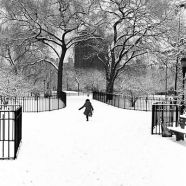





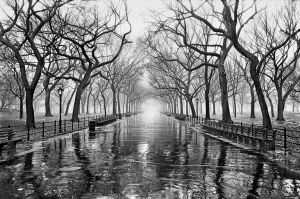
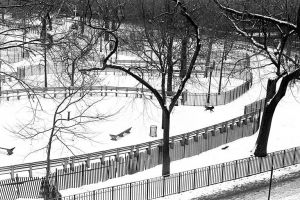
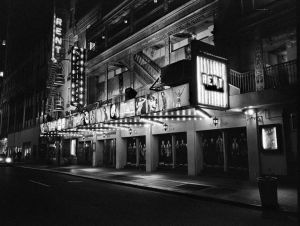
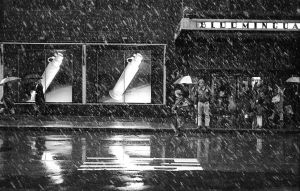
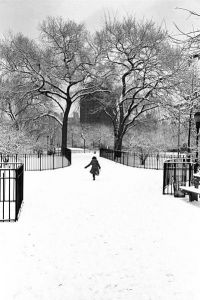

Another brilliant essay by a brilliant photographer.
Beautifully and thoughtfully written. It lasts.
“Literature saved me.”
Yes. And the photography.
Your essay makes me want to run outside, set my camera to b&w and shoot until I’m exhausted. Tried to decide if I enjoyed your essay as much as your photographs but then gave up.
Call it a draw.
I don’t know which is more beautiful…your words or your photographs. Interesting insight from a professional to an amateur photographer…me! Thanks for sharing…
Gosh.
Just wonderful, John. You nailed it, you romantic, you.
Thank you for this beautifully written insight into life and photography.
Your prose is poetry….which somehow also conjures the visual eye to open wide.
John done, is doing, fine art.
Exquisite. The essay and the photographs.
Thank you for sharing this.
John, such beautiful writing, thank you!
I had no idea you have as much talent in writing as you do in photography.
Congrats on a beautiful piece.
Jim
John, I enjoyed this essay as I always enjoy reading your work. You capture the evanescence of our earthly existence and remind us of the directives – and the detours and inspiration – that we find along the way. The imagery of your writing is lovely and vivifying as always.
Very moving, John. It’s generous of you to be so open about your thinking and story. You have photos with just a tinge of color in them that I love, ochre, rust or indigo. They too whisper.
I HAVE KNOWN JOHN FOR MANY MANY YEARS AND HAVE COLLECTED A NUMBER OF BRILLIANT PHOTOGRAPHS. MY FAVORITES ARE THE ONES HE SHOT IN CENTRAL PARK SOME OF WHICH HANG ON MY WALLS AND SOME IN CINCINNATI ON MY DAUGHTER’S WALLS.
TWO OF MY FAVORITE PHOTOS ARE THE LITTLE BOY (JOHNNY?)STANDING ON A CHAIR IN A FIELD AND THE LITTLE GIRL SITTING BENEATH A PAINTING BY VAN GOGH IN THE ART MUSEUM. BUT THERE ARE SO MANY MORE TO LOVE.
HEY, JOHN…HERM ALSO WENT TO CHESHIRE ACADEMY AND PROBABLY FOR THE SAME REASONS.
Eloquence. Courage. Honesty. Thank you.
I have long enjoyed your photographs, and am grateful to have received them over the years. These commentaries help me see more deeply into them. The whole essay is a beautiful piece of writing, and the Rembrandt section is truly a prose poem. My hat’s off to you!
“the indecisive moment”
Perfect
The rain in the street scene in front of Bloomingdales is great, especially with your words in this great piece.
Bravo John, a beautiful description of your coming of age.
He whispered with shadows and light.
I haven’t received one of your emails for a long time. Was wondering about you the other day. And then I opened this in my inbox this morning. I don’t know you well but always welcome your sharing. Perhaps one day we’ll sit beside one again at Beth’s and Alan’s dinner table. Always fun and enlightening. Thank you.
The only thing better than the photographs is your illuminating text, so beautifully drawn. It’s a wonderful thing to have someone else’s memories become so vividly your own, if only for a few moments. Looking at these photographs, stark reminders of the very recent dull, wintry past, the colors of the bluebirds, pine warblers and cardinals just sing.
Winter Light, Spilled Light, Rembrandt Light, Illumination, Falling Light, each section an ode to transformation.
Beautifully crafted, John.
Another beautiful moment shared with John and his insight into the ordinary and beyond.
Beautiful photos and essay. I had no idea we had such an artist on the same street!
Thank you for your beautiful shared moments in photography and writing.
Don’t we all start out as the stars of our own lives? A lucky few come to realize it and to step quietly to the back of the auditorium. Even fewer have the insight to recognize and reflect so beautifully on the process of coming to really know oneself.
John, You have my attention. I don’t want to miss a thing.
Oh John. This brings back to me how fervently I would wait for your commentaries on NPR. And how often I had wished there was a volume of your writing – your gorgeous ringing thoughts and words – on my shelf of favorite books to return to again and again. I still hope for that. Such images equal to your photographs … “pallor of sorrow” for example. Your deep reading through your eyes and your pen – your exquisite mind – is such a gift. I can’t think of a more perfect definition of literature, of all art really, than the one herein.
You haven’t missed a beat, John. Even as your photographs have grown even quieter, filled with gorgeous whispers, your prose dances and struts and kicks up a thoughtful storm. Keep on.
John, this is wonderful, the perfect pairing of word and image…somehow I always think you are writing about ME. Maybe we all think this.
Lee Smith